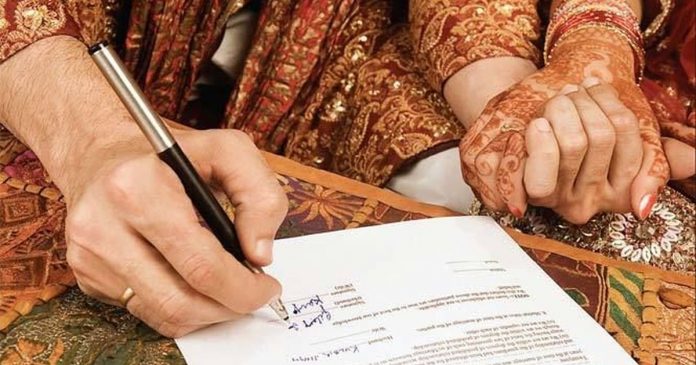This article is written by Gursimran Kaur Bakshi, from the National University of Study and Research in Law, Ranchi. This article will guide you step by step on how to apply for a marriage certificate during the COVID-19 pandemic.
Table of Contents
Introduction
There is no doubt on how the COVID-19 pandemic has severely impacted the plans of many who were planning to get married. Now, for getting married, a good internet connection is as important as a requirement for two people to marry each other. Nevertheless, the process of registering a marriage and procuring a marriage certificate remains difficult. With the raging pandemic, this has become a herculean task.
Let’s understand, first, how in normal circumstances, one can apply for a marriage certificate and how this process has changed during the COVID-19 pandemic.
What are the laws through which you can get a marriage certificate
Marriage in India is regulated through two major enactments, namely the Hindu Marriage Act, 1955 and the Special Marriage Act, 1954. Let us first understand what is the definition of marriage under the two Acts respectively.
Conditions of marriage and registration under the Hindu Marriage Act, 1955
Under the Hindu Marriage Act, 1955, a marriage is considered a sacrosanct institution between a male and a female. The Act applies to persons who are Hindu (including Virashaiva, a Lingayat or a follower of the Brahmo, Prarthana or Arya Samaj), Buddhist, Jaina, and Sikh as per Section 2(1).
Conditions to marry under the Act
The requisite conditions to solemnise a marriage under Section 5 of the Act are:
- The marriage can only be solemnised between two Hindus, one of whom is a male that has completed the age of 21 years and the other is a female, who has completed the age of 18 years old, at the time of the marriage.
- Neither of them should have a spouse living at the time of the marriage.
- Neither of them should be incapable of giving valid consent as a consequence of unsoundness of mind. If one of the parties is capable of giving valid consent but suffers from a mental disorder of such a kind or to such an extent as to be unfit for marriage and the procreation of children including a condition when the person suffers from recurrent attacks of insanity. Then these conditions are also considered as an incapability to get married.
- Lastly, the parties should not be within the degree of prohibited relationships including that they are not sapindas of each other. An exception to this is that the custom or usage governing each of the parties permits marriage between the two.
Now, these are the conditions that are required to be fulfilled by the parties to marry each other under the Act. Once these are done, the next step is to perform a Hindu marriage as per the customary rites and ceremonies under Section 7 of the Act. Such rites and ceremonies may include the Saptapadi which is a ritual of taking seven steps by the bridegroom and the bride jointly before the sacred fire (Saat Phere). Once this is done, the marriage is said to be complete and binding when the last seventh step is taken.
Conditions to register marriage under the Act
The next and the most important step is to do registration for marriage. The registration of marriage is done for the respective state government to maintain proof of it under the Hindu Marriage Register under Section 8 of the Act. Under the Hindu Marriage Register, the state government requires that certain particulars relating to the marriage are entered in the manner prescribed under the rules and the failure to do so can result in a fine which may extend to twenty-five rupees. The power to make rules for the registration of marriage is exercised by respective state governments. The Supreme Court has observed in Seema v. Ashwini Kumar (2006), that the state government must enact rules for the compulsory registration of marriage.
Some states have enacted legislation governing the compulsory registration of marriage and since the judgment, other states have also enacted the same. These are:
- Odisha Hindu Marriage Registration Rules, 1960
- Chandigarh Hindu Marriage Registration Rules, 1966
- Pondicherry Hindu Marriage (Registration) Rules, 1969
- Uttar Pradesh Marriage Registration Rules, 1973
- Karnataka Marriages (Registration and Miscellaneous Provisions) Act, 1976
- Himachal Pradesh Registration of Marriages Act, 1996
- Jammu and Kashmir Muslim Marriages Registration Act, 1981
- Andhra Pradesh Compulsory Registration of Marriages Act, 2002
- Chhattisgarh Compulsory Marriage Registration Rules, 2006
- Bihar Marriage Registration Rules, 2006
- Mizoram Compulsory Registration of Marriages Act, 2007
- Kerala Registration of Marriages (Common) Rules, 2008
- Madhya Pradesh Compulsory Marriage Registration Rules, 2008
- Haryana Compulsory Registration of Marriages Act, 2008
- Tamil Nadu Registration of Marriages Act, 2009
- Rajasthan Compulsory Registration of Marriages Act, 2009
- Uttarakhand Compulsory Registration of Marriage Act, 2010
- Punjab Compulsory Registration of Marriages Act, 2012– This Act covers the Hindu Marriage Act, 1955, the Indian Christian Marriage Act, 1872, the Muslim Personal Law (Shariat) Application Act, 1937, and any other custom or personal law relating to marriage.
- Tripura Recording of Marriage Act, 2003 (as amended in 2013)
- Delhi (Compulsory Registration of Marriage) Order, 2014– This order is applicable to persons irrespective of religion and creed.
- Meghalaya Compulsory Registration of Marriages Act, 2012 (as amended in 2015)
Conditions of marriage and registration under the Special Marriage Act, 1954
Conditions to marry under the Act
Under the Special Marriage Act, 1954, the conditions of marriage as laid down under Section 4 of the Act are almost the same as that of Section 5 of the Hindu Marriage Act, 1955. The difference is that in the Special Marriage Act, 1954, the marriage between the prohibited relationship is allowed, if the custom of at least one of the parties permits it.
Under the Hindu Marriage Act, 1955, the custom and usage of both parties should allow for the same. The term custom in the context of the Special Marriage Act, 1954, means rules in relation to a person belonging to any tribe, community, group, or family which the state government has notified in the official gazette on behalf of them. The rule has been continuously and uniformly observed by the members of the tribe, community, or group, it must not be unreasonable or opposed to public policy, and should not be discontinued by the family.
Conditions to register under the Act
To register under the Special Marriage Act, 1954, a marriage officer is appointed by the state government to whom a notice of marriage is to be given in writing before the marriage is solemnized. The notice should be given in the form as specified in the Second Schedule of the Act to the marriage officer in the district where at least one of the parties to the marriage has resided thirty days immediately preceding the date of the notice. The marriage officer may publish the notice to invite objections to the marriage. However, there is no mandatory requirement to publish the notice according to the Allahabad High Court’s judgment of Safiya Sultana v. State of Uttar Pradesh (2021). The court held that Section 6(2) of the Act requiring to mandatorily publish the notice is constitutionally impermissible in line with the requirements of the fundamental right to privacy under Article 21 of the Indian Constitution.
Further, the parties along with three witnesses need to sign a declaration in the presence of the marriage officer as per the form specified in the Third Schedule and the declaration shall be countersigned by the marriage officer. The marriage can be solemnized in the presence of the marriage officer or at a reasonable distance with parties in the presence of the three witnesses and the marriage officer pronouncing, “I, (A), take the (B), to be my lawful wife (or husband)”.
Lastly, once the marriage is solemnised, the marriage officer shall enter a certificate in the form as specified in the Fourth Schedule in the marriage certificate book and such certificate shall be signed by the parties to the marriage and three witnesses as per Section 13 of the Act.
Reasons to compulsorily register a marriage
There is a reason why the Supreme Court and various other High Courts have vouched for compulsory registration of a marriage. It is important to officially register a marriage because it provides security to a woman in terms of evidence in cases where the existence of marriage is denied by the husband or vice-versa. Compulsory registration allows the state to keep track of the number of child marriages which are taking place illegally under the Prohibition of Child Marriage Act, 2006 and for the custody of the child when the parents decide to separate.
It also extends protection to women under the Protection of Women Against Domestic Violence Act, 2005, in seeking maintenance under Section 125 of the Code of Criminal Procedure, 1973, and for the restitution of conjugal rights of the parties. It would also help the state to punish the culprit for dowry death under Section 498A of the India Penal Code, 1860. At the same time, proof of marriage is also necessary to counter any frivolous petition of dowry death claims.
Steps to register marriage under various state legislations
Under the Uttar Pradesh Hindu Pradesh Marriage Registration Rules, 1973
As per these rules, the registrar general can enter the particulars of marriage in the marriage register once the parties have filled the Form-A with the requisite court fees mentioned under the Act. The application for registration shall be made in duplicate to the registrar under whose jurisdiction the marriage has been solemnized and it should be made in triple if the marriage is solemnised under the jurisdiction where the husband permanently resides.
Under the Punjab Compulsory Registration of Marriages Act, 2012
Within a period of three months from marriage, the parties (the married bridegroom and bride), any of their parents or relations shall prepare and sign a marriage memorandum and a duplicate copy of that should be submitted to the registrar of marriage. It shall be signed by the priest, attested by the parties, and should be accompanied by the requisite court fee stamps. The memorandum should prove that the marriage has taken place according to the personal rites and ceremonies, there must be witnesses to testify that the marriage has taken place, and the marital status of the parties should be clear. If all the information is not disputed, the registrar can enter the same in the marriage register. If there are objections pointed out by the registrar, the same can be solved with further evidence and information as asked by the registrar. The maximum delay in the submission of the marriage memorandum should not be more than six months after the stipulated period of three months.
Under the Delhi (Compulsory Registration of Marriage) Order, 2014
The Marriage officer must register the marriage within 60 days of the marriage excluding the day when the marriage was solemnised. The parties have to jointly fill Form-A along with the documentary proof such as the photos of the ceremony, place of marriage, identification of the parties to name a few. All this should be accompanied by a fee of two hundred rupees. On being satisfied, the officer can enter the details in the register and request the parties to appear again along with two witnesses bearing the permanent residence proof of Delhi to certify the solemnization. Parties can also avail of Tatkal (urgent) registration with fees of ten thousand rupees.
Steps to register for a marriage certificate online during the COVID-19 pandemic
As it is impossible to register a marriage by visiting the marriage registrar in the nearest jurisdiction of the parties, they can opt for the same through the online portal. State governments under their respective Acts have the power to establish online portals for the registration of marriage both under the Hindu Marriage Act, 1955, the Special Marriage Act, 1954, and any other marriage Act. The links of some of these portals are mentioned below:
Delhi
Online registration can be done through the e-district portal of the Delhi Government where the user has to first click on the option to register on the website, then click on the option of ‘applying for services’ where option 32 is registration of marriage under the Department of Revenue. Go to the option of download, click on option number 31 within it and download the registration form. The registration is Aadhaar based and requires the parties to fill in basic documentary details on the identity of the parties, solemnization of marriage, witnesses, and place of marriage along with a declaration.
Uttar Pradesh
Registration can be done through the IGRSUP website. The registration of marriage is Aadhaar-based and both parties can register by filling up the online form.
Maharashtra
Marriage can be registered through the Bombay Municipal Corporation’s website. Go to the website, click on the ‘my citizens’ option, then choose the option of registration of marriage. An online Form-D will appear which is a memorandum of marriage that needs to be filled by the parties. The details of both the bride and groom along with their identity and residence proof are required along with the details of three witnesses and the priest. All the details have to be filled along and the payment has to be done to procure a certificate.
Goa
Parties can register through the Online Registration of Marriage Portal by the Department of Registration. The first step is to click on the applicant registration option, select the marriage registrar office within the taluka of your residence, upload the scanned copies of photographs of bride and groom, documents of birth certificates of both, a document of proof of residence issued within of last month before applying for marriage declaration of one of the parties, identify proof of both, and document proof of witness.
Madhya Pradesh
Registration can be done through the e-Nagar Palika portal. Click on the option ‘to apply’ and choose a city to proceed forward to the form. Individual options will appear for the bride, groom, and the witness to fill in the details and then the documents can be uploaded. The details of the two witnesses are required. Individual photos of bride and groom, marriage photos, ID proof of parties, an undertaking from both, and the ID proof of witnesses need to be uploaded as documents. A marriage certificate should be collected within six months of marriage.
Haryana
Registration can be done through the Haryana Marriage Registration portal. First, register and make an account on the website. Once you register and sign in, click on the option of register marriage then fill in the area and place of registration. Details of the bride, groom, and two witnesses need to be filled in along with their identity proof. Once the details are filled in and payment is done, the parties are required to schedule an appointment with the nearest marriage registrar by clicking on the option of my registration and then on the view tab.
Punjab
The marriage registration form is available in the Government of Punjab portal click on the option to avail of services, then click on the registration of marriage, fill up the details of bride, groom, and those of two witnesses along with a declaration of a priest, and submit it.
Conclusion
Registration of marriage is not a very difficult task provided the ceremonies and rites of the marriage take place as per the personal laws of the parties and there is enough documentary proof to substantiate the same. With COVID-19, these conventional methods of registration may not work and hence, the bare minimum such as performing ceremonies in front of witnesses, identification of the parties, and proof of solemnization should be maintained by the parties properly.
Further, there must not be a delay in the registration because it may take more time than usual during the pandemic. It is suggested that the central government enact uniform legislation for the registration and issuance of marriage certificates, divorce certificates, and other similar documents so that there is a disparity in the different legislations of the states which are often confusing to the common citizen.
References
- https://legislative.gov.in/sites/default/files/A1954-43_1.pdf
- https://devgan.in/crpc/section/125/
- https://prsindia.org/files/bills_acts/acts_states/punjab/2013/2013PB1.pdf
- https://legislative.gov.in/sites/default/files/A2007-06.pdf
- https://www.indiacode.nic.in/bitstream/123456789/15436/1/protection_of_women_from_domestic_violence_act%2C_2005.pdf.
- e.com/ALL/up425.htm
- https://www.indiacode.nic.in/show-data?actid=AC_CEN_5_23_00037_186045_1523266765688§ionId=46286§ionno=498A&orderno=562
- https://punjab.gov.in/forms/
- https://indiankanoon.org/doc/1037437/
- https://shaadi.edisha.gov.in/
- https://www.mpenagarpalika.gov.in/irj/portal/anonymous/CitizenServices/MarriageRegistration/qlMarriageRegistrationForm
- http://www.bareactslive.com/Pun/PU274.HTM
- https://www.livelaw.in/top-stories/notice-of-intended-marriage-publication-optional-special-marriage-act-allahabad-high-court-168356.
LawSikho has created a telegram group for exchanging legal knowledge, referrals, and various opportunities. You can click on this link and join:












